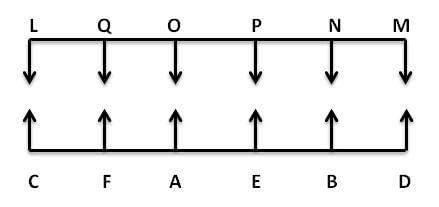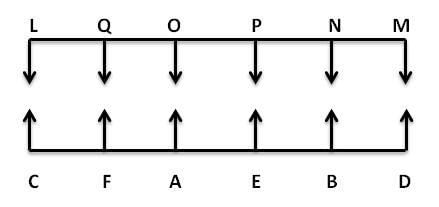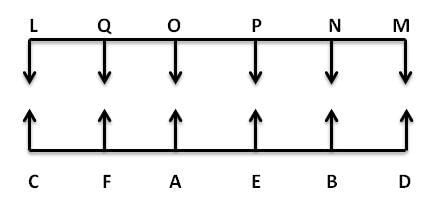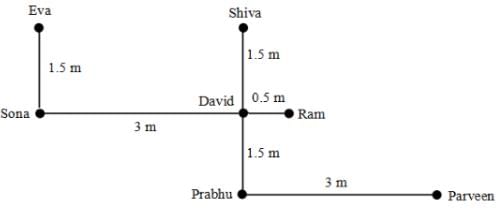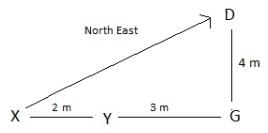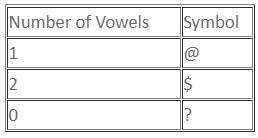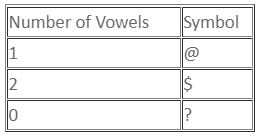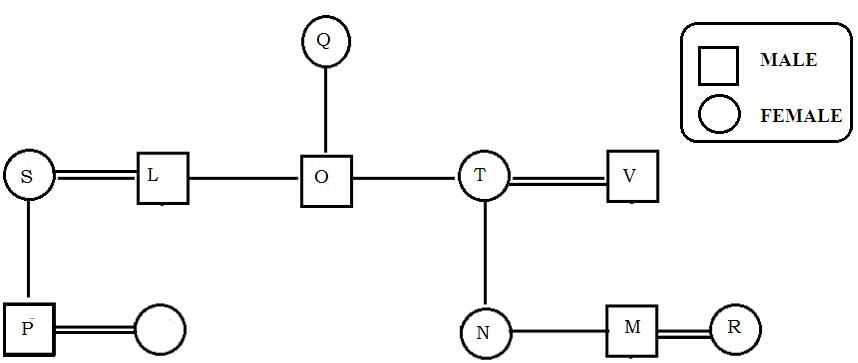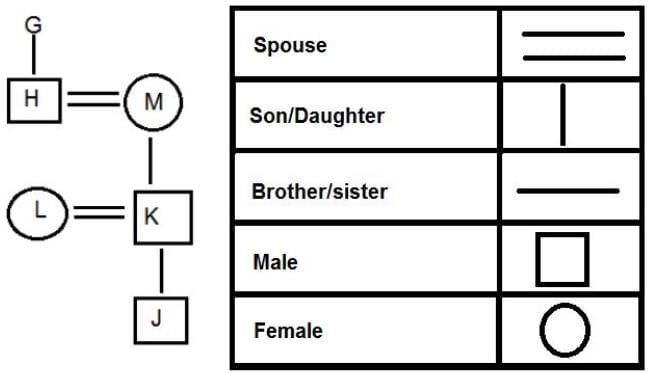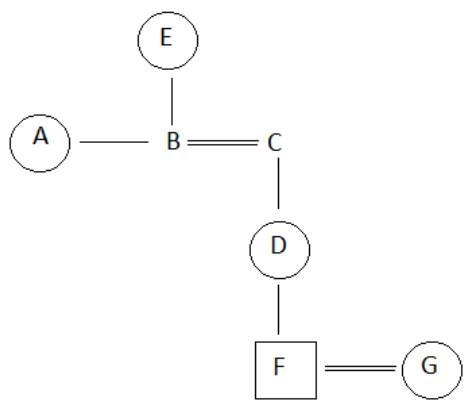Canara Bank PO Mock Test - 3 - Banking Exams MCQ
30 Questions MCQ Test - Canara Bank PO Mock Test - 3
In each of the following questions two statements are given. Which are followed by four conclusions (1), (2), (3) and (4). Choose the conclusions which logically follow from the given statements.
Q.
Statements: No door is dog. All the dogs are cats.
Conclusions:
- No door is cat.
- No cat is door.
- Some cats are dogs.
- All the cats are dogs.
Statements: All green are blue. All blue are white.
Conclusions:
- Some blue are green.
- Some white are green.
- Some green are not white.
- All white are blue.
Statements: All men are vertebrates. Some mammals are vertebrates.
Conclusions:
- All men are mammals.
- All mammals are men.
- Some vertebrates are mammals.
- All vertebrates are men.
Statements: All the phones are scales. All the scales are calculators.
Conclusions:
- All the calculators are scales.
- All the phones are calculators
- All the scales are phones.
- Some calculators are phones.
Statements: Some tables are T.V. Some T.V. are radios.
Conclusions:
- Some tables are radios.
- Some radios are tables.
- All the radios are T.V.
- All the T.V. are tables.
Question:
In a certain code, 'XYZ' means 'We are friends'. Which letter stands for 'We'?
Statements:
I. 'PYN' means 'They are classmates'.
II. 'ZMS' means 'We love them'.
III. 'PX' means 'Hello friends',
Question:
Among P, Q, R, S and T, Q is the second tallest and S is immediate taller than the shortest. Who among them is in the middle when they stand in the order of their heights?
Statements:
I. T is not the shortest.
II. R is taller than S but shorter than Q.
III. P ranks third in height above S when all are arranged in the order of height.
Question: Four subjects - Physics, Chemistry, Mathematics and Biology - were taught in four consecutive periods of one hour each starting from 8.00 a.m. At what time was the Chemistry period scheduled ?
Statements:
I. Mathematics period ended at 10.00 a.m., which was preceded by Biology.
II. Physics was scheduled in the last period.
III. Mathematics period was immediately followed by Chemistry.
Question:
What is the total monthly salary of Vasu?
Statements:
I. Vasu's basic salary is Rs 100 more than Rajan's salary who also serves in Vasu's company.
II. Other allowances drawn by Rajan besides his basic salary are Rs 2000 per month which is Rs 50 less than Vasu's salary.
III. Rajan's basic salary is Rs 1550 per month,
Question:
Who is the tallest among six boys P, T, N, D, Q and R?
Statements:
I. P is taller than D and N but not-as tall as T.
II. R is taller than Q but not as tall as T.
III. Q is not taller than T and R.
Directions to Solve
In each word of the following questions consists of pair of words bearing a relationship among these, from amongst the alternatives, pick up the pair that best illustrate a similar relationship.
Question -
Silence : Noise
Directions to Solve
In each word of the following questions consists of pair of words bearing a relationship among these, from amongst the alternatives, pick up the pair that best illustrate a similar relationship.
Question -
Kick : Football
Directions: Study the following information to answer the given questions
Twelve people are sitting in two parallel rows containing six people each, in such a way that there is an equal distance between adjacent persons. In row-1 L, M, N, O, P and Q are seated and all of them are facing South. In row-2 A, B, C, D, E and F are seated and all of them are facing North. Therefore, in the given seating arrangement each member seated in a row faces another member of the other row. O sits third to right of M. Either O or M sits at an extreme end of the line. The one who faces M sits second to right of E. Two people sit between B and F. Neither B nor F sits at an extreme end of the line. The immediate neighbor of B faces the person who sits third to left of L. N and P are immediate neighbors of each other. C sits second to the left of A. P does not face the immediate neighbor of D.
Q. Who amongst the following sit at extreme ends of the rows?
Directions: Study the following information to answer the given questions
Twelve people are sitting in two parallel rows containing six people each, in such a way that there is an equal distance between adjacent persons. In row-1 L, M, N, O, P and Q are seated and all of them are facing South. In row-2 A, B, C, D, E and F are seated and all of them are facing North. Therefore, in the given seating arrangement each member seated in a row faces another member of the other row. O sits third to right of M. Either O or M sits at an extreme end of the line. The one who faces M sits second to right of E. Two people sit between B and F. Neither B nor F sits at an extreme end of the line. The immediate neighbor of B faces the person who sits third to left of L. N and P are immediate neighbors of each other. C sits second to the left of A. P does not face the immediate neighbor of D.
Q. How many persons are seated between Q and N?
Directions: Study the following information to answer the given questions
Twelve people are sitting in two parallel rows containing six people each, in such a way that there is an equal distance between adjacent persons. In row-1 L, M, N, O, P and Q are seated and all of them are facing South. In row-2 A, B, C, D, E and F are seated and all of them are facing North. Therefore, in the given seating arrangement each member seated in a row faces another member of the other row. O sits third to right of M. Either O or M sits at an extreme end of the line. The one who faces M sits second to right of E. Two people sit between B and F. Neither B nor F sits at an extreme end of the line. The immediate neighbor of B faces the person who sits third to left of L. N and P are immediate neighbors of each other. C sits second to the left of A. P does not face the immediate neighbor of D.
Q. L is related to A in the same way as O is related to B based on the given arrangement. To which of the following is P related to, following the same pattern?
Directions: Study the following information to answer the given questions
Twelve people are sitting in two parallel rows containing six people each, in such a way that there is an equal distance between adjacent persons. In row-1 L, M, N, O, P and Q are seated and all of them are facing South. In row-2 A, B, C, D, E and F are seated and all of them are facing North. Therefore, in the given seating arrangement each member seated in a row faces another member of the other row. O sits third to right of M. Either O or M sits at an extreme end of the line. The one who faces M sits second to right of E. Two people sit between B and F. Neither B nor F sits at an extreme end of the line. The immediate neighbor of B faces the person who sits third to left of L. N and P are immediate neighbors of each other. C sits second to the left of A. P does not face the immediate neighbor of D.
Q. Which of the following is true regarding P?
Directions: Read the following information carefully and answer the questions.
Twelve people are sitting in two parallel rows containing six people each, in such a way that there is an equal distance between adjacent persons. In row-1 P, Q, R, S, T and V are seated and all of them are facing South. In row-2 A, B, C, D, E and F are seated and all of them are facing North. Therefore, in the given seating arrangement each member seated in a row faces another member of the other row. S sits third to right of Q. Either S or Q sits at an extreme end of the line. The one who faces Q sits second to right of E. Two people sit between B and F. Neither B nor F sits at an extreme end of the line. The immediate neighbor of B faces the person who sits third to left of P. R and T are immediate neighbors of each other. C sits second to the left of A. T does not face the immediate neighbor of D.
Q. P is related to A in the same way as S is related to B based on the given arrangement. To which of the following is T related to, following the same pattern?
Sona is 1.5 m South of Eva. Ram is 3 m East of Sona and David is 0.5 m West of Ram. David is 1.5 m South of Shiva and Shiva is 3 m North of Prabhu. Praveen is 3 m East of Prabhu. In which direction is Prabhu from Eva?
Directions: Read the following information carefully and answer the question given below.
A * B means A is to the left of B at a distance of 2 m.
A & B means A is to the west of B at a distance of 3 m.
A © B means A is to the south of B at a distance of 4 m.
A £ B means A is to the north of B at a distance of 3 m.
It is given that all the persons face north.
Q. If we have X * Y & G © D, then in which direction is D with respect to X?
Directions: Study the following information carefully and answer the question given below.
In a certain code language:
'fried pastry chef shape' is written as '15$W 18@B 12@U 15$V'.
'dough egg treat serve' is written as '15$S 9@T 15$G 15$V'.
'ball twist small sweet' is written as '12@O 15@G 15@O 15$G'.
'sour state own crypt' is written as '12$I 15$V 9@M 15?G'.
Q. What is the code for 'spy team lost'?
Directions: Study the following information carefully and answer the question given below.
In a certain code language:
'fried pastry chef shape' is written as '15$W 18@B 12@U 15$V'.
'dough egg treat serve' is written as '15$S 9@T 15$G 15$V'.
'ball twist small sweet' is written as '12@O 15@G 15@O 15$G'.
'sour state own crypt' is written as '12$I 15$V 9@M 15?G'.
Q. What will be the code for 'loud cry kid'?
Directions: Study the following information carefully and answer the question given below.
In a certain code language:
'these phones nothing buyers' is coded as t#l e@i n@v e#s.
'team trees time twist' is coded as i@n e@z e#i i#d.
'better brick brain beside' is coded as t@v i@w i#i a#i.
'kites kiwi art blue' is coded as t#r t#i l@f i@d.
Q. In the given code language, what does the code 'a@i r#z a@t' represent?
Directions: Read the following information and answer the question given below.
In a family of eleven, M is the son of O's mothers's daughter. Q is the mother of L and T. L and O are brothers. N is the daughter of T, who is the wife of V. P is the son of S, who is the daughter-in-law of Q. L is the father-in-law of P's wife. R is the daughter-in-law of V.
Q. Who is M's mother?
Directions: In the following question, the symbols #, @, $, *, &, %, = and ! are used with the following meanings as illustrated below. Study the following information and answer the given question:
A # B - A is brother of B.
A @ B - B is the child of A.
A $ B - B is daughter-in-law of A.
A * B - B is elder than A.
A & B- B is son of A.
A % B- A is the wife of B.
A = B - A is husband of B.
A ! B - A is brother-in-law of B.
Q. If the expression G @ H = M $ L % K & J holds true, then how is M related to J?
Directions: In this problem, the symbols ?, #, $, *, &, ^, % and @ are used with the meanings as illustrated below. Study the given information and answer the following question:
P ? Q → 'P is the mother of Q.'
P # Q → 'P is the child of Q.'
P $ Q → 'Q is the sibling of P.'
P * Q → 'Q is younger than P.'
P & Q → 'Q is the daughter of P.'
P ^ Q → 'P is the husband of Q.'
P % Q → 'P is the grandparent of Q.'
P @ Q → 'P is the sister-in-law of Q.'
Q. If E ? B * A @ C & D ? F ^ G, A $ B and the elder child of E is married, then who among the following is the granddaughter-in-law of C?
Directions: Read the following information carefully and answer the question that follows.
In a village of Bastar district in Madhya Pradesh, only two types of people live who belong to a tribal class. The first type is known as class A, while the other is known as class B. In that village, there is no other type of person except these two. The activities of both types of people are governed by perfectly patterned norms of social behaviour. Each person of the tribe has to obey the norms. They are rigid about this.
As far as marriage is concerned, the following norms are to be followed:
(A) The people of class A cannot marry any other member of their own class, though they can marry members of class B.
(B) After being married, each male member ceases to be member of that class in which he was born, but automatically he becomes the member of the other class to which his wife belongs.
(C) As far as females are concerned, they remain the members of their own class after being married.
(D) On its birth, the child automatically becomes the member of its mother's class.
(E) When any male member becomes widower or divorcee, then he again belongs to the group in which he was born.
(F) Nobody can marry more than one person according to social laws.
Q. A boy who was born in class B (boy and his wife both can have married and unmarried brothers) can have
Directions: Read the following information carefully and answer the question that follows.
In a village of Bastar district in Madhya Pradesh, only two types of people live who belong to a tribal class. The first type is known as class A, while the other is known as class B. In that village, there is no other type of person except these two. The activities of both types of people are governed by perfectly patterned norms of social behaviour. Each person of the tribe has to obey the norms. They are rigid about this.
As far as marriage is concerned, the following norms are to be followed:
(A) The people of class A cannot marry any other member of their own class, though they can marry members of class B.
(B) After being married, each male member ceases to be member of that class in which he was born, but automatically he becomes the member of the other class to which his wife belongs.
(C) As far as females are concerned, they remain the members of their own class after being married.
(D) On its birth, the child automatically becomes the member of its mother's class.
(E) When any male member becomes widower or divorcee, then he again belongs to the group in which he was born.
(F) Nobody can marry more than one person according to social laws.
Any female of class B can have
(P) grandfather (father's father) born in class B
(Q) grandmother (father's mother) born in class B
Directions: Study the following information carefully and answer the question given below.
A word and number arrangement machine, when given an input line of words and numbers, rearranges them following a particular rule.
Following is an illustration of input and the rearrangement:
Input: each still 59 home 78 18 money 43 with 28 97 zoo
Step I: 97 each still 59 home 78 18 money 43 with 28 zoo
Step II: 97 zoo each still 59 home 78 18 money 43 with 28
Step III: 97 zoo 78 each still 59 home 18 money 43 with 28
Step IV: 97 zoo 78 with each still 59 home 18 money 43 28
Step V: 97 zoo 78 with 59 each still home 18 money 43 28
Step VI: 97 zoo 78 with 59 still each home 18 money 43 28
Step VII: 97 zoo 78 with 59 still 43 each home 18 money 28
Step VIII: 97 zoo 78 with 59 still 43 money each home 18 28
Step IX: 97 zoo 78 with 59 still 43 money 28 each home 18
Step X: 97 zoo 78 with 59 still 43 money 28 home each 18
Step XI: 97 zoo 78 with 59 still 43 money 28 home 18 each
Step XI is the last step of the arrangement of the above input as the intended arrangement is obtained.
As per the rules followed in the above steps, answer the question that follows based on the input given below:
Input: long done 37 gang 51 young 107 63 tin 25 vehicle 89
Q. In step VII, which of the following words/numbers would be at the 5th position from right?
Directions: Study the following information carefully and answer the question given below.
A word and number arrangement machine, when given an input line of words and numbers, rearranges them following a particular rule.
Following is an illustration of input and the rearrangement:
Input: each still 59 home 78 18 money 43 with 28 97 zoo
Step I: 97 each still 59 home 78 18 money 43 with 28 zoo
Step II: 97 zoo each still 59 home 78 18 money 43 with 28
Step III: 97 zoo 78 each still 59 home 18 money 43 with 28
Step IV: 97 zoo 78 with each still 59 home 18 money 43 28
Step V: 97 zoo 78 with 59 each still home 18 money 43 28
Step VI: 97 zoo 78 with 59 still each home 18 money 43 28
Step VII: 97 zoo 78 with 59 still 43 each home 18 money 28
Step VIII: 97 zoo 78 with 59 still 43 money each home 18 28
Step IX: 97 zoo 78 with 59 still 43 money 28 each home 18
Step X: 97 zoo 78 with 59 still 43 money 28 home each 18
Step XI: 97 zoo 78 with 59 still 43 money 28 home 18 each
Step XI is the last step of the arrangement of the above input as the intended arrangement is obtained.
As per the rules followed in the above steps, answer the question that follows based on the input given below:
Input: long done 37 gang 51 young 107 63 tin 25 vehicle 89
Q. In which step is the output '107 young 89 vehicle long done 37 gang 51 63 tin 25' obtained?
Directions: Study the following information carefully and answer the question given below.
A word and number arrangement machine, when given an input line of words and numbers, rearranges them following a particular rule.
Following is an illustration of input and the rearrangement:
Input: each still 59 home 78 18 money 43 with 28 97 zoo
Step I: 97 each still 59 home 78 18 money 43 with 28 zoo
Step II: 97 zoo each still 59 home 78 18 money 43 with 28
Step III: 97 zoo 78 each still 59 home 18 money 43 with 28
Step IV: 97 zoo 78 with each still 59 home 18 money 43 28
Step V: 97 zoo 78 with 59 each still home 18 money 43 28
Step VI: 97 zoo 78 with 59 still each home 18 money 43 28
Step VII: 97 zoo 78 with 59 still 43 each home 18 money 28
Step VIII: 97 zoo 78 with 59 still 43 money each home 18 28
Step IX: 97 zoo 78 with 59 still 43 money 28 each home 18
Step X: 97 zoo 78 with 59 still 43 money 28 home each 18
Step XI: 97 zoo 78 with 59 still 43 money 28 home 18 each
Step XI is the last step of the arrangement of the above input as the intended arrangement is obtained.
As per the rules followed in the above steps, answer the question that follows based on the input given below:
Input: long done 37 gang 51 young 107 63 tin 25 vehicle 89
Q. Which of the following would be the final step?




